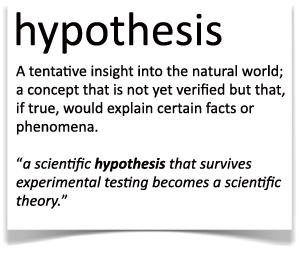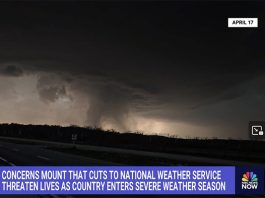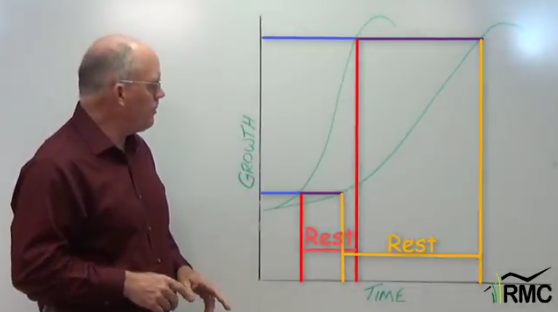 If you’ve heard that grazing is good for the planet because it can sequester more carbon in the soil, you’re not alone. The hypothesis goes like this: When livestock take a bite of grass, the grass plant sloughs off an equal amount of root mass below ground. That dead material is full of carbon. Microbes in the soil eat the carbon, and turn it into a stable substance so the carbon is safely sequestered below ground. They also trample some forage into the soil, making more food for microbes. So grazing creates more forage, more meat production, and a healthier climate.
If you’ve heard that grazing is good for the planet because it can sequester more carbon in the soil, you’re not alone. The hypothesis goes like this: When livestock take a bite of grass, the grass plant sloughs off an equal amount of root mass below ground. That dead material is full of carbon. Microbes in the soil eat the carbon, and turn it into a stable substance so the carbon is safely sequestered below ground. They also trample some forage into the soil, making more food for microbes. So grazing creates more forage, more meat production, and a healthier climate.
It’s an interesting hypothesis, and hypotheses are where all scientific discovery begins. Someone has an idea about how a process works, and then sets up tests and experiments to see if the idea holds water. So, on behalf of our On Pasture community, we decided to look into it.
 We started where all researchers start: with a review of what scientists have already discovered from working on this topic. There’s a LOT out there.
We started where all researchers start: with a review of what scientists have already discovered from working on this topic. There’s a LOT out there.
So far, we’ve read over 100 scientific papers published between 1998 and 2016. Each of those papers cite at least 50 additional papers that supported them in their work. And, of course, each of those support papers cite even more papers. It’s a lot to digest.
Let’s start with the basics of what the research tells us. We’ll go into more detail in future articles.
What we’ve learned from our reading so far:
Grazing itself does not seem to have much influence on increasing carbon in the soil.
The carbon cycle is very complex and there are lots of things influencing how carbon gets into the soil, how long it stays there, and what makes it head back into the atmosphere. Our reading has revealed that precipitation, soil type and its potential for absorbing more carbon, as well as the kind of vegetation growing in the pasture, all determine what happens to a much greater degree than grazing does.

It turns out that, though grasslands cover about 1/3 of the planet, there are other agricultural lands with greater potential to sequester carbon. The more degraded a soil is, the higher its potential for improvement. Dr. Rattan Lal, who has studied environmental quality and sustainability, and soil degradation and restoration for over 50 years, says, “…the potential of SOC [soil organic carbon] sequestration is in the following order: degraded soils and desertified ecosystems > cropland > grazing lands > forest lands and permanent crops.” (Pg. 14 of Lal – Soil carbon sequestration to mitigate climate change, April 2004, Geoderma 123 (2004) 1-22.)
Here’s another important piece:
While grazing may not be the silver bullet, it’s an important part of the carbon cycle.
Good grazing produces food and fiber while keeping the soil covered with vegetation, improving water storage, preventing erosion and nutrient migration, maintaining water quality, and providing wildlife habitat. These are all vital ecosystem services. Good grazing management is also important to allowing the seasonal uptake of carbon to be as great as it can be, and to ensuring that the carbon we’ve got in the soil doesn’t oxidize and head back into the atmosphere at a greater rate.
Done poorly, grazing can have negative effects. Grazing too early in the season reduces the leaf surface area that’s so important for the seasonal uptake of carbon into the soil. Practices that encourage shorter rooted vegetation over longer rooted plants also reduce seasonal uptake. Finally, grazing so that we leave the soil bare through the winter can turn grasslands into carbon sources.
So, is soil the answer?
Let’s check back in with Dr. Lal for the answer to that question:
“People should know that soil is part of the solution, and agriculture can be part of the solution,” he says. “That’s an important message.”

To figure out how large a role agriculture can play, Dr. Lal looked at the global soil carbon pool, historic carbon loss and the capacity of the world’s degraded agricultural soils to store carbon. He looked at strategies like woodland regeneration, no-till farming, cover crops, improved grazing, and compost, sludge and manure applications, and calculated how rapidly they could increase the soil carbon pool. His estimate, reported in Geoderma, is that the global potential of soil organic carbon sequestration through these practices is .9 (plus or minus .3) gigatons of carbon per year.
That’s a lot. But it’s only one-fourth to one-third of the estimated 3.3 gigatons in annual increase of atmospheric CO2.
So soil may not be THE answer. But it is part of the answer. And the best part of this answer is that as we work on our part of the answer, we’re restoring degraded soils, enhancing forage and food production, purifying surface and ground water, and reducing the rate of enrichment of atmospheric CO2. That’s a pretty good thing.
Ready for Part 2? Here you go!





Thank you, Kathy.
I thought to share a link to a report called, “Grazed and Confused: Ruminating on cattle, grazing systems, methane, nitrous oxide, the soil carbon sequestration question – and what it all means for greenhouse gas emissions” (phewf) which was released yesterday. Written and published by the Food Climate Research Center, Oxford Martin Programme on the Future of Food and Environmental Change Institute, University of Oxford, I think that there will be some insight to these correlations. The full report is quite the document so I haven’t gotten through it all myself but you can find a summary and downloadable report from the link below.
http://www.fcrn.org.uk/projects/grazed-and-confused
As practioners I believe that it’s our duty to embrace science and also to voice our on-the-ground observations in our management. As Fred Provenza and Michel Mueret posit in their book, “The Art and Science of Shepherding: Tapping the Wisdom of the French Herders” it’s the marriage of both science and experiencial wisdom that is necessary to get the full picture.
Thanks again for sharing this work.
All the best,
BCB
I’ve read that 127 page report in its entirety. In regards to soil carbon and grazing management, this “new” report repackages a 2016 paper by Norborg. The “new” report quite literally cut and pasted content from this 2016 paper and accepted Norborg’s findings uncritically. Unfortunately Norborg’s meta analysis omitted a lot of research on this topic. So in borrowing and repackaging Norborg, the “new” FCRN report made the same omissions.
Michigan State’s Dr. Jason Rowntree wrote the following response to the FCRN paper and a few others citing these omissions in this article- https://sustainabledish.com/beef-isnt-to-blame/#
Here is Dr. Rowntree reply without the hyperlinks in this linked article:
====================================
There have been recent reports that range from the acknowledgement of grazing management positive influence of ecosystem services, but not as an efficacious tool in reducing atmospheric CO2 to the denigration of grazing livestock as viable components of terrestrial landscapes.
There is a large and ever-growing database, mostly not acknowledged in the recent reports, documenting the positive impacts of grazing on soil carbon along with improvements in other ecosystem services that is consistent with what Allan Savory has been saying for years. To put these numbers into perspective a mid-size car emits around 1.28 metric tons of carbon (converted from carbon dioxide) annually into the atmosphere.
In 2001, Rich Conant and Keith Paustian, at Colorado State University, published a meta-analysis of 115 ranches from a variety of global environments indicating a mean annual 0.54 metric tons of carbon sequestered per hectare (ha) demonstrating the capacity for soil to capture and store carbon. In 2011, Teague et al. investigated the impact of high and low continuous grazing as compared to adaptive multi-paddock grazing (AMP) in Texas (the approach advocated by Savory) and indicated the AMP treatment had an annual 3 metric tons of carbon sequestered in the soil above and beyond that of the continuously grazed treatments.
USDA ARS scientist Alan Franzluebbers, has indicated high potential in the eastern US as well. In Nature, Machmuller et al, report over an 8 metric ton annual increase in carbon sequestration over a 3 year period following the conversion of degraded cropland to grazing land in Georgia. For context to meet an overall carbon sink (or storage capacity) for a Midwest grass-finishing beef system, our work indicate a needed 0.89 metric ton carbon sequestration to offset the entire footprint, including that from enteric methane emitted by cattle. This seems plausible based on the existing carbon sequestration literature.
Finally, the most downloaded manuscript in the Journal of Soil and Water Conservation, for 2016-17 cites the beneficial components of AMP and conservation agriculture on North American food production. The authors, of which Rowntree is one, estimate that if these conservation approaches were completed on 25% of our crop and grasslands, the entire carbon footprint of North American agriculture could potentially be mitigated.
Holistic Management is used by thousands of practitioners over millions of hectares of land. Proper adoption of animals to landscapes over a variety of precipitation levels is an efficacious land management tool. We have been on many of these ranches. Our laboratory is currently summarizing a large Patagonia dataset with ecosystem measurements on over 2 million hectares of land mostly managed holistically, that is, using a decision-making framework that helps land managers to move toward their goals in a way that is economically, ecologically, and socially sound in their context. Attempting to reduce the complexity of land management to just animals and time in a reductive scientific environment, is no different than splitting hydrogen from oxygen to study water.
Dr. Jason Rowntree, Michigan State University
Stefhan, thank you for your comments. We have read the articles and the report you mention, and we will be addressing these in later articles.
Dr Lal’s assertion about which soils can store more carbon make sense logically because those soils start with an empty “carbon account” think bank account so there is more room. My hypothesis has been that not just root pulses but transport of manure by dung beetles and the addition of urine add biologically active bacteria, and other microbes.
A key indicator in my experience is that the US is farming the grasslands that had the highest carbon storage and we have been mining that carbon since those areas were settled. Many pastures are on formerly wooded sites. I too look forward to more insight and thanks for what you do!
Dr. Lal has written a lot more recent articles than the one cited from 2004. The research has stayed static. Here’s a paper he co-authored in 2016 http://www.jswconline.org/content/71/2/156.full.pdf
Thanks, Kathy. I am looking forward to the next part.
Comments are closed.